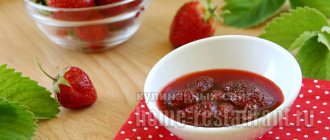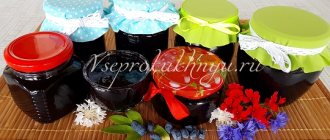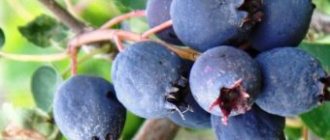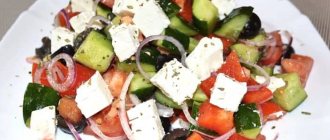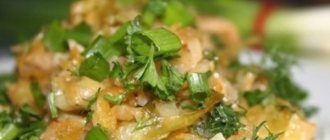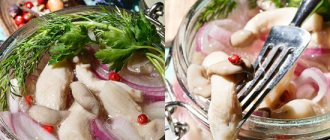Let's find out reliable details about nature's gift, the exoticism of which will surpass mangoes and avocados. Many people have heard about feijoa, but not everyone has tried it. Useful properties and contraindications, recipes, myths, advertising noise and real benefits. Where does feijoa grow? How to properly peel it and can it be eaten with the peel on? What dishes to prepare? Read about everything important in the review of this unusual fruit.
Some disappointment awaits those looking for fantastic benefits and therapeutic wow effects. We rely on the actual composition of the product and modern nutritional science. Therefore, below you will not find mythical promises akin to “vitamin bomb!” or “cures impotence and migraines in just 3 days!”
Already know about the benefits and harms of fruit and want to move on to practical advice?
Click on point No. 5 - how to choose ripe fruit, quickly peel it and cook it deliciously.
A bit of botany and geography
The word itself is of Portuguese origin. This is the popular name for the flowering shrub acca sellowiana from the myrtle family. It grows up to 7 meters in height, and its homeland is South America. Neither the Indians nor the conquerors had a high opinion of the plant, so some specimens reached Europe only in the 19th century. People were mainly attracted by lush flowers with a large number of stamens.
The flowers of the plant can be eaten. They taste like cotton candy with a fruity aroma.
The shrub combines capriciousness and endurance. Shade, drought, salt in the soil, frost, strong wind, lack of insect pollinators. The plant can survive all these troubles, but will refuse to bear fruit. Entire gardens of bushes can be found in its native soils of Brazil, Argentina and Paraguay, as well as in California and New Zealand.
In Russia, bizarre flora grows in the Crimea and the North Caucasus. But most of the sales come from fruits native to the South Caucasus - Abkhazia, Georgia and Azerbaijan. The harvest season is short: usually autumn and the very beginning of winter.
Photo of feijoa on a tree
Photos of feijoa flowers
As with watermelon, banana and kiwi, from a botanical point of view it is more correct to call feijoa a berry. But tradition is tradition: everything larger than a gooseberry is popularly considered a fruit - we will adhere to it too.
Ripe fruits are close to the size of a large chicken egg. The diameter of the handsome ones is 5-6 cm, the average weight is 50 grams. There is no need to pick them - they fall from the bush on their own. Alas, exotics do not retain their presentation for very long. Ripe fruits do not tolerate shaking well, quickly become overripe and begin to rot.
You rarely see our heroes in supermarkets. The product has become more popular in bazaars and markets.
Feijoa
Winter is very close and the flu is spreading somewhere. But readers of Culinary Eden are not afraid of seasonal troubles - thrifty cooks have prepared berry jellies and jams rich in vitamins, and the collection of healthy vitamin-rich aromatic desserts will be replenished with one more - from feijoa fruits. The amazing pineapple-strawberry flavor with hints of banana plus a very high iodine content make feijoa not only a rare delicacy with a wonderful taste and aroma, but also a useful and necessary means of maintaining health.
Feijoa
(Feijoa) or as the Indians call it -
akka
comes from South America. It grows in Brazil, Colombia, Uruguay and northern Argentina. This plant is new to the European diet. In the 19th century, during a detailed study of the continent and classification of plants that were especially suitable for food, the attention of researchers was attracted by greenish fruits growing on small evergreen trees of the myrtle genus. The fruit received its name from its discoverer, the Brazilian naturalist Joao da Silva Feijo. The fruits of the South American feijoa are greenish in color with a reddish tint, oval in shape with a diameter of 4-6 cm and a length of up to 10 cm. Each weight is about 40 grams. The pulp is juicy, sour-sweet with an aroma reminiscent of pineapple and strawberries at the same time. Feijoa is one of the most cold-resistant tropical plants - it tolerates frosts down to -14 degrees without much damage.
In our area, that is, on the Eurasian continent, feijoa has taken root and lives in warm countries. Feijoa is grown in the south of Russia - in the Krasnodar Territory, as well as in Crimea, Georgia and Azerbaijan. The history of the appearance of this healthy fruit in Europe and North America begins in 1890, when the plant was brought to France. 10 years later, in 1900, feijoa was planted in the Crimea near Yalta and Sukhumi. In 1901, feijoa was brought to California, where it took root well and its cultivation began. In 1913, feijoa was planted in Italy, from where the fruit spread throughout the Mediterranean, simultaneously adapting to the cooler climate of its native subtropics and moving further north. Having “lived” in our area, the feijoa became so hardened that it began to withstand frosts down to -11 degrees (Crimea) without significant damage, and record-breaking feijoas withstood frosts down to -14 degrees. The frost resistance of the fruit makes it suitable for growing in the southern part of our country and the Far East, where warm winters allow feijoa to safely continue bearing fruit the next year.
The “highlight” of the fruit, its uniqueness and main value is considered to be the highest iodine content of all known plant or animal products. It is iodine that improves memory and speeds up thought processes. Iodine monitors the health of the thyroid gland and helps control metabolism with the help of 2 hormones produced by the thyroid gland - thyroxine and triiodothyronine. These two hormones are involved in providing the body with the energy necessary for mechanical work, for the normal course of biosynthesis processes, tissue renewal and many others. Simply put: if there is iodine in the body, a person is cheerful, fresh, full of strength, slowly gets tired and can do a lot, if there is no iodine, a person is depressed, lethargic, gets tired quickly and feels empty, including mental. These are, of course, extreme forms, but such an exaggerated picture better helps to understand the importance of this element. And since the element is so important, then every product containing iodine is especially valuable. Let's make a reservation - industrial vitamins, various additives and other chemistry with iodine, in addition to poor digestibility, are dangerous due to iodine imbalance, that is, an excess, and it is not so easy to understand exactly how much iodine is needed. Natural plant and animal sources of iodine are devoid of this unpleasant feature, and feijoa is the main and primary fruit - a source of iodine.
Iodine is not contained in all feijoas, but only those grown on soils similar in composition to their native South American ones. For example, feijoa grown in Batumi has a fairly low iodine content, and some fruits contain only traces of iodine.
In addition to beneficial iodine, feijoa contains 93 useful substances, and that is why feijoa can be considered a piggy bank of useful substances. It contains vitamins (almost all), fiber, pectins, malic acid, essential sugars, micro- and macroelements. The skin contains phenolic compounds - catechins, leukoanthocyanins, soluble tannin, which give the astringent taste. The skin is quite easily separated from the pulp and is usually not used for food.
In addition to regulating the function of the thyroid gland, fresh feijoa fruits, mashed with sugar, are recommended for atherosclerosis, vitamin deficiency, hypovitaminosis, inflammatory processes of the gastrointestinal tract, pyelonephritis and gastritis. For skin diseases, the essential oil of the fruit is used as an anti-inflammatory.
Feijoa is actively used in cooking. The fruits are used to make preserves, jams, compotes, juice, salads and sauces. The exotic fruit is so loved in European countries that many peoples consider feijoa part of their culinary heritage. For example, in Georgia, feijoa is one of the products used in traditional cooking.
Feijoas are often eaten fresh; to do this, the peel is removed, cut in half and sometimes sprinkled with sugar, but more often they are eaten just like that. To serve feijoa in its raw form, ripe fruits are required, since they have soft whitish jelly-like pulp and a rich strawberry-pineapple aroma. Feijoa is great for making sauces and sweet desserts - jams, preserves, marmalades. From unripe fruits you can prepare compotes, juices, a variety of non-alcoholic cold cocktails, liqueurs, liqueurs and use as the fruit part of alcoholic cocktails. In the confectionery industry, feijoa is one of the exotic ingredients for filling expensive sweets.
To serve fresh, feijoa fruits are peeled and the pulp is cut into convenient pieces - into slices or circles. Feijoa will decorate any fruit salad. Sometimes feijoa is served with meat dishes and, of course, the famous Georgian sauces with the advent of such aromatic fruit have replenished their composition with several varieties based on or with feijoa inclusions.
Feijoa has its own “season” when the fruit is available in large quantities and is relatively inexpensive. This is approximately from the beginning of September to the beginning of January. Around November and early December, feijoa becomes cheaper and it becomes possible to make an inexpensive stock.
Feijoa is difficult to store. When fresh, it will “last” a little more than a week, after which it will begin to wither and lose its taste. The best solution is to process it into sauces, preserves, jams and anything else that your imagination allows. Naturally, not forgetting to eat as much fresh feijoa as possible at the same time.
The simplest option is to make jam. To do this, you will need to grind the feijoa (for example, in a meat grinder), mix with sugar (20% of the weight of the fruit), add water and cook for six hours, skimming off the foam from time to time and stirring. You need to cook over low heat or, even better, in a water bath. Try adding fresh grated ginger to the jam. The combination of spicy ginger and aromatic feijoa will give ordinary jam new taste and depth. Pass the resulting jam through a sieve to separate the seeds, ginger fibers and other unnecessary parts.
There is also a more “sugar” version of jam. It is even easier to prepare: washed feijoa fruits along with their skins are passed through a meat grinder (or crushed in a blender) and covered with sugar. Proportions: per kilogram of fruit, kilogram of sugar. The jam is not boiled, but only occasionally stirred so that the sugar dissolves. Sometimes the mass is heated, but only so that the sugar dissolves faster.
Be sure to try making the sauce! Feijoa sauce is a special chic. Especially if the sour sauce is intended for a meat dish, and especially for poultry. The sauce is made using the same technology as jam, only without sugar. Please note that although there will be no sugar in the sauce, it will still be sweet. Sweet sauces for meat are a special delicacy, but if such combinations are unacceptable for you, you can add a little white or black pepper to the mixture and heat well in a non-stick pan or just a thick-walled one. Pass the finished sauce through a sieve in the same way as the jam. For piquancy, you can add a drop of crushed garlic (about a third of a clove per 500 ml of sauce), besides, garlic should always be present in the autumn-winter diet. But do not overdo it with seasonings - the fruit taste and aroma should dominate the sauce.
The combination of feijoa with fish or seafood is no less refined and tasty. Use large fish species. Feijoa can serve as a filler, and then chop the fruit and stuff the fish with it, or feijoa serves as a side dish for fish, and this combination itself can bring many minutes of pleasure - fruity aroma and fried fish. If you decide on a side dish, add boiled carrots and Brussels sprouts, just don’t mix, let all the ingredients be at hand, and the right combinations will come up by themselves. For sauce, try two options: honey (preferably liquid) or pesto sauce.
Alexey Borodin
Chemical composition and calorie content
For 100 grams of feijoa:
- Calorie content - 49 - 2%
- Proteins - 1.2 g
- Fats - 0.8 g
- Carbohydrates - 10.6 g
- Dietary fiber - no
Vitamins:
- C - 20.3 mg - 34%
- B9 – 38 mg – 10%
Minerals:
- Iodine - from 70 mcg - from 45%
- Potassium - 155 mg - 4%
- Manganese - 0.1 mg - 4%
USDA data. The percentage value is the proportion of the daily value (DV) of an adult with a balanced diet of 2000 kcal. Only essential nutrients are indicated: from 4% DV.
Health Benefits
It may seem that a considerable price is based on the special benefits for the body. In fact, the main reasons for the high cost of green babies in our latitudes are their perishable nature and difficulties in achieving yield. Heroes, of course, have usefulness, but it is very limited.
Judge for yourself what vitamins are in feijoa by looking at the chemical composition above.
Note! Much more affordable, kiwi is much richer in both vitamin C and folic acid.
With the exception of vitamins C and B9, 100 grams of our heroes do not contain a large concentration of nutrients. The product does not contain calories, proteins, fats, carbohydrates and does not contain dietary fiber. Minerals are present in small quantities.
The only trump card of the curiosity is its high iodine content:
- from 70 to 250 mcg per 100 grams, and the daily human need for iodine is only 150-300 mcg.
But regular iodized salt will also help satiate the lack of iodine. Here you can find out how to get the most out of it, as well as a complete overview of iodine for human health.
It’s even more beneficial to introduce seaweed (kelp), which holds the record for iodine content, into your diet. Or drink algae as a supplement if you don’t like the taste or are afraid of Chinese counterfeits.
Exotics do not contain a large amount of polyphenols. Those that are available are concentrated in the skin, not the pulp.
Place in healthy eating
We can use the product during the short ripeness season with ordinary health effects. It is advisable to enhance the benefits by properly combining them with other gifts of nature.
- To support immunity, it is better to accompany the review heroes with products with vitamins A, E, zinc and selenium. Salads with chicken, fish, ham, eggs, nuts and greens are smart choices for a full complement of antioxidants.
- Pregnant women can eat feijoa as a source of folic acid for the full development of the child’s nervous system.
- For variety when losing weight, you can include this wonder in salads and drinks on a healthy diet or in extended stages of protein diets. It does not have any special “fat-burning” properties, nor does it have an abundance of fiber necessary for high-quality cleansing.
- It is permissible to try it in a modern low-carbohydrate diet for diabetes mellitus - at the stage of remission under glucose control 1.5 hours after eating.
Feijoa: health benefits and harms
The secret to boosting immunity by cooking feijoa is its high iodine content. This microelement has only one consumer in the body – the thyroid gland.
But on its basis (plus the amino acid tyrosine) it produces thyroxine, a precursor hormone to triiodothyronine, which regulates:
- digestion;
- body temperature;
- growth processes;
- heart function and blood flow;
- synthesis of new proteins, including immune ones;
- cycle in women;
- sperm maturation – in men;
- speed and quality of tissue regeneration of all types;
- vitamin exchange.
The normal production of thyroxine helps increase immunity, regardless of the reasons for its decrease. The iodine required for its production is extremely rare in nature. In addition to feijoa and prepared recipes based on it, its main source is seafood, mainly plants (it is found in fish and crustaceans, but in trace quantities).
In feijoa grown near the sea, the concentration of the microelement often exceeds that of seaweed with scallops. “Land” and unripe specimens are not its rivals, but it can be a good idea to cook them as a supplement 3-4 times per week of the course.
At the same time, boosting immunity by taking feijoa and alternative iodine-rich dishes/recipes/supplements is fraught with the development of autoimmune reactions, especially skin reactions, such as psoriasis. Allergies are also promoted by its saturation with ascorbic acid. But if you cook feijoa at too high a temperature, some of it will collapse. Its constant overdose threatens thyroiditis, Graves' disease and other forms of degradation of the thyroid gland with:
- formation of a characteristic goiter;
- increased body temperature, heart rate and metabolism;
- bulging eyes;
- constant hunger and weight loss;
- sweating;
- tremor of the limbs.
When including recipes with feijoa in your diet, it is important not to “overdo it” with it, especially in combination with other sources of iodine. Up to 1 mg is required per day (2 is the absolute limit). And in terms of “per” the amount of feijoa pulp and/or skin, the indicated norm is 300 g per day.
The need for a microelement increases slightly in women in the last week before menstruation, while in men it is stable.
Myths and contraindications
So far, no significant cases of intolerance have been identified. Whether this is due to their hypoallergenic nature, or simply to a banal lack of data for statistics, we will let you judge.
For ourselves, we are wary of any new products, especially in the nutrition of children. An unshakable rule is a daily allergy test. We eat a small piece and observe the early signs of an allergic reaction, as well as general well-being for 24 hours. Early signs include a sore throat, burning sensation in the mouth, difficulty breathing, swelling of the face and larynx, and hives on the skin. Long-term symptoms include gastric and intestinal dyspepsia (heartburn, nausea, flatulence, stool disorder).
"Miracle! Green babies enhance male potency!”
This is the most common myth from experienced market traders. They like to replicate the advertising mantra on the Internet. However, we did not find scientific confirmation of this property. Manganese may serve as a remote basis for such a statement, but it contains no more than 4% of DN per 100 grams (2 pieces of medium size).
- If you're serious about your men's reproductive health, consider zinc to help them stay lean and physically active.
How to select and store
Let us immediately note that sellers at markets often offer these fruits, even when they are no longer edible. This is due to the perishable nature of the product and the desire to at least return the money invested in the product.
Just a month from falling from the bush is the optimal shelf life of the curiosity. Often this period of time is not enough to collect the delicacy, prepare it for shipment, bring it to Moscow or St. Petersburg, and at the same time maintain its pristine ripeness.
How to choose ripe feijoa?
- Press it with your thumb. The ripened fruit yields slightly to pressure, but does not seem soft. Avoid fruits with dents. They will very soon begin to rot (or are already rotting). A bad sign is also abrasion and roughness.
- The pulp appears translucent. A dense white color on the cut is a sign of immaturity.
- Pay attention to the skin. It has a bright light green color. A whitish coating is acceptable, which can be easily wiped off with a finger.
What does ripe pulp taste like?
It looks like jelly and resembles strawberry and kiwi at the same time. Connoisseurs say: barely noticeable notes of pineapple are a special charm of the wonder.
How to choose ripe feijoa
What distinguishes an overripe fruit? Expressed softness. Don't buy such fruits. They taste bad.
What makes it unripe? Excessive hardness. This is the product that is often present in the markets. In an effort to maximize the period when fruits are suitable for sale, suppliers pick them from the bushes while they are still green.
How to speed up ripening at home?
Leave the fruit in the kitchen in the same paper bag as the bananas. However, experts believe that unripe beauties are never destined to compare in taste with their initially ripe counterparts.
Three storage rules
- Be sure to store in the refrigerator.
- Try to eat within 2-3 days of purchase.
- Can also be frozen in the freezer. The preparation will be edible for up to 8 months.
How to eat properly
You can eat feijoa in different ways - with or without the peel. Contrary to popular belief, the outer skin is completely edible. But it has a specific taste, so it has not won many fans.
We offer you a choice of two ways to get to the juicy pulp.
- Cut in half and scrape out the pulp with a pointed teaspoon. This is how they eat nature's gift in Latin America.
- Arm yourself with a knife or vegetable peeler and carefully remove the green skin. Important point: if you are not going to eat the peeled fruit immediately, place it in a bowl of water and lemon juice. Otherwise, the pulp will quickly turn brown under the influence of atmospheric oxygen.
Feijoa sauce for meat
For the sauce you will need
- an arbitrary number of feijoas and tangerines (proportion one to four).
- also take sugar, salt, olive oil, cumin - to taste.
You can experiment and instead of tangerines take oranges, lemon or lime, or several fruits together!
Cooking
- Grind the unpeeled feijoas and peeled tangerines in a blender.
- Add seasonings and olive oil, mix everything.
- The sauce is ready, they need to pour over the meat a couple of minutes before cooking so that the sauce has time to warm up and the meat is a little saturated with it.
It turns out to be a very interesting taste! The sauce can also be served separately with meat or boiled pork.
style=”display:block” data-ad-client=”ca-pub-6392505925759923″ data-ad-slot=”4294660522″ data-ad-format=”auto”>

